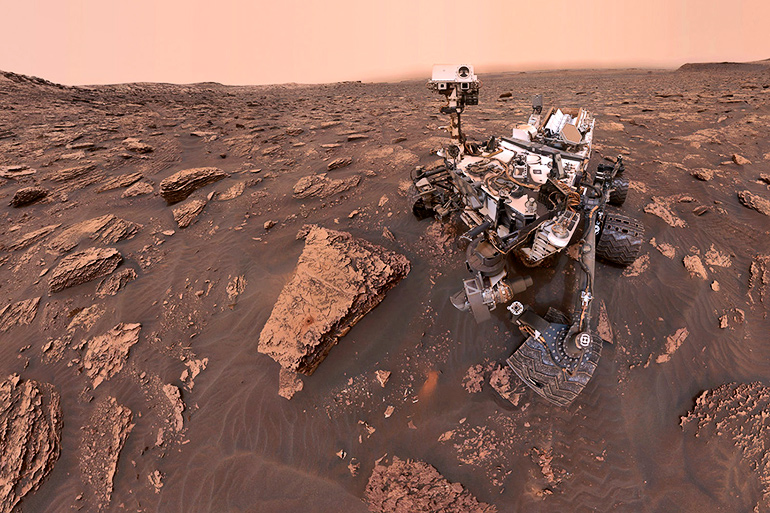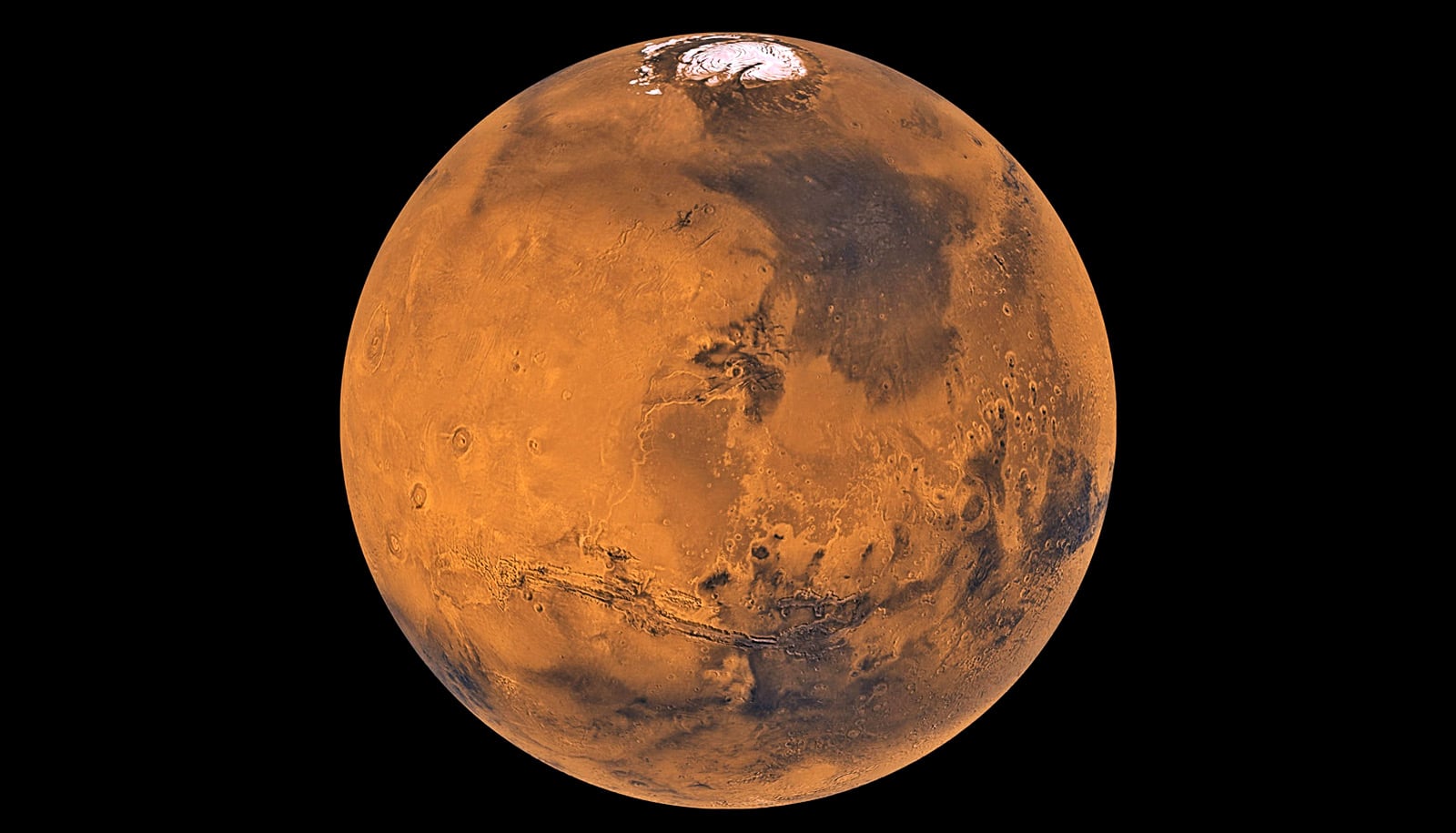A flurry of Mars-related news has generated a lot of attention for the red planet and raises questions about where it all fits into what we already know.
Since June, we’ve heard about two indicators of possible life on Mars and the fate of the rover Opportunity, shrouded in one of the planet’s global dust storms. We’ve also looked back on rover Curiosity’s mission and forward to how humans may someday step foot on Mars.
“From an academic viewpoint, space has enormous ability to stimulate interest in everybody and particularly students,” says Scott Hubbard, an adjunct professor of aeronautics and astronautics at Stanford University, former director of NASA Ames, and author of Exploring Mars: Chronicles from a Decade of Discovery (UA Press, 2012). “I’ve done lots of speaking at middle schools and if you talk about either dinosaurs or astronauts, the kids get excited.”

Here, Hubbard explains several of the recent headline-grabbing stories about what’s happening, what’s next, and what it all means.
The biggest news lately is the announcement of a possible underground lake on Mars. We’ve heard news about water on Mars before—what’s different about this discovery?
When I was NASA’s Mars program director, the slogan was “follow the water” because liquid water is necessary for all life as we know it. Water shapes planets, it determines the climate—past and present—and, of course, if people are planning to live there, you need water.
In 2012 the European mission Mars Express started getting data on this discovery and continued collecting it for three years. The instrument it used is a ground-penetrating radar called MARSIS, which is a technology we use to locate underground fluids—oil, water—on Earth, too. What they found was a reflection that was very strong, such that the only interpretation that this group could find that fit with the data was liquid water.
So, there is a liquid water lake, roughly 20 kilometers in diameter about 1 kilometer below the surface. They’ve made guesstimates of the volume and it would be in the millions and millions of gallons of water.
This is the first-ever really solid detection of liquid water. In the past, it’s been ice, it’s been glaciers, it’s been past water that dried up or turned into ice. This is a huge, huge discovery.
At this point, it’s not certain what else might be mixed in with the water. From a detailed analysis, they believe it’s probably very, very salty water. And probably very cold, too.
People who want to speculate about life would say very salty water means life probably couldn’t live there. But if you’ve ever flown into San Francisco airport and looked out at the salt flats, you see this reddish color out there. What you’re looking at are halophiles, organisms that evolved to be perfectly happy in extremely salty water. So, if there was life on Mars and it followed the water underground, could it have evolved to live in a very salty environment? Up to a point, yes.
It was recently Curiosity’s sixth birthday on Mars. Looking back on its time there, what do you think about the rover’s accomplishments?
The prime mission for Curiosity was one Mars-year (two Earth-years) and it has exceeded that substantially. It has made a number of terrific discoveries, the most recent one of which is the first-ever detection of complex organics—materials made of a few atoms of carbon and hydrogen that could indicate biological reactions.
The rover had previously detected simple organics—which could result from all kinds of non-biological reactions—but this was something called kerogen. Kerogen on Earth is the fossilized leftovers of algae and plants. So, does this come from the same source? We don’t know. But it is what we had been looking for: a sign that there was some biology going on.
Curiosity was the last of a series of orbiters and landers of evermore-increasing capability. This started with the little test rover, the Mars Pathfinder, then Spirit and Opportunity which are real geophysical laboratories.
If there are any fingerprints of life anywhere on Mars, the job of this Curiosity was to drill in and extract that rock, put it in its incredibly elaborate and sophisticated on-board chemistry set—the Sample Analysis for Mars or SAM—and see what’s there.
NASA recently says that terraforming Mars seems very unlikely, given present-day technology. Should we be disappointed?
I think NASA was saying that we understand the appeal of this idea but if you look at the actual situation with Mars, the chemistry you would have to do on a global scale, it looks like something that is not 20 years but maybe 200 years in the future. I don’t think that article says it was impossible but it says that it is really out there at the border between science and science fiction.
There’s also a whole ethical aspect of this that people bring up: Should we do this? But humans are always going to be explorers. Not everybody wants to leave the cave where it’s nice and safe and warm, but some fraction always will.
By asking the question about what we might do, you stimulate the thoughts. If people never thought a hundred years, a thousand years into the future, we wouldn’t be making the advances we are today.
There is also a global dust storm happening on Mars right now that has prevented Opportunity from communicating. What can you tell us about that situation?
Very shortly after the Viking mission landed in the ’70s, all the surfaces started getting covered by the red dust. It’s everywhere on Mars.
When we were deciding how to make Spirit and Opportunity—which are solar-powered—we looked at the accumulation rate of the dust and were certain the dust would cut the power permanently within six months. I described this as, “the warranty was only good for 90 days,” and we decided to get all the major top priority science done in that timespan to be sure we got the payoff from these rovers.
Now, Spirit lasted seven years before getting stuck in the sand and Opportunity is in its 14th year. The reason it has lasted is because dust devils come by and clean off the solar panels. We knew the dust devils existed but when they did this one day, everybody was just completely astounded.

But what nature giveth, nature can taketh away. Now we have a global dust storm and the only thing that’s running is a clock. It wakes up and says, do I have sun? No? Back to sleep. Even if the dust devils are cleaning the rover, the dust in the sky is blocking the sunlight.
And so we just don’t know what will happen.
We don’t know if the batteries will last. The big concern, though, is the electronics freezing, which happens at about minus-40 degrees Centigrade. The good news is that dust storms warm the atmosphere and the coldest they’ve seen in this environment is about minus-30 degrees C. So, it has a chance of lasting until the storm blows itself out and it can charge up again.
Most of the dust on Mars comes from this one spot
It seems like sending people to Mars was a hot topic a few years ago and we don’t hear much about it anymore. What’s the current state of that goal?
NASA had been planning to send humans to Mars in the 2030s and I chaired an independent study that showed how it could be done on a budget that is plausible by using a minimum architecture—not trying to do everything. However, this new administration has announced a pivot to the moon.
There are a lot of questions in the space community about what that means because if you went full-bore on a return to the moon the way it has been suggested in the past—building a base and infrastructure and rockets—that would delay, in my view, humans to Mars by another generation.
Did heavy rain give Mars its deep valleys?
So, will this succeed? Among presidential announcements of this nature, Kennedy’s in 1961 was the only success. That was because Lyndon Johnson was able to get the budget of NASA up to 4 percent of the federal budget. It was a huge spike. It’s been around half a percent since 1975.
If you’re going to succeed, you’re going to need some other approach. There’s going to have to be international partners and entrepreneurs because the one that has worked is the one that spent an enormous amount of money.
Exploring space is inspirational, it provides high-tech jobs and helps the economy, it shows worldwide leadership. I hope elected officials, entrepreneurs, and our international colleagues will continue the investments for many years to come.
Source: Stanford University



